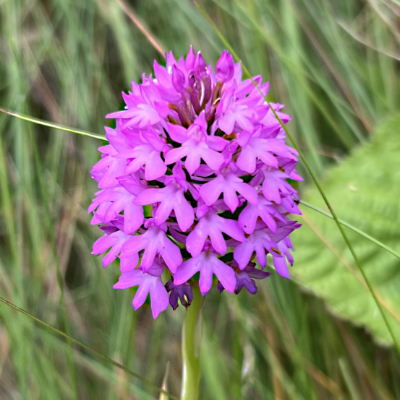
 |
|
Scientific Classifications explained » Amphibians » Ants » Aphids » Bees » Beetles » Birds » Bugs » Butterflies » Caterpillars » Damselflies » Dragonflies » Earwigs » Flies » Frog/Leafhoppers » Fungi » Galls » Grasshoppers » Harvestmen » Hoverflies » Lacewings » Ladybirds » Leaf Mines » Lichens » Mammals » Millipedes » Mosses » Moths » Sawflies » Slugs » Snails » Spiders » Trees & Shrubs » Wasps » Wild Flowers » Woodlice » Postboxes |
UK Nature > Wild Flowers > Red & Pink Wild Flowers > Anacamptis pyramidalis

Scientific Name: Anacamptis pyramidalis Common Name: Pyramidal Orchid Anacamptis pyramidalis, the pyramidal orchid, is a small orchid that lives up to its name - its pink flower spike forms a pyramidal shape. It grows on chalk grassland, coastal habitats, scrub, roadside verges, old quarries and railway embankments. It flowers in June and July with its densely packed flower spike holding up to 100 flowers. It attracts a range of butterflies and moths and is easy to identify - the pyramidal orchid displays bright pink flowers in a dense, pyramid-shaped cluster at the top of its stem. It has long, narrow and pointed leaves. Widespread in England Wales, but scarcer in Scotland. Orchid seeds do not store enough food to grow on their own, so they team up with a mat-forming fungus in the soil. In turn, the orchid’s roots protect the fungus. |
|

https://www.uknature.co.uk is a website dedicated to showing the immense diversity of UK nature and wildlife. Our vast range of habitats, from lowland arable to snow covered mountains, from storm-ravaged coastlines to peaceful inland freshwater lakes and rivers, from dry, sandy heaths to deciduous and coniferous forests, all these habitats contribute to the abundance of UK nature. We have wild birds in huge numbers either residing or visiting our shores (597 recorded species as at July 2013) and we must also not forget the humble back garden with its grass lawns, flower beds filled with nectar rich flowers, shrubs and trees, all designed to attract huge numbers of insects such as bees, moths, butterflies and hoverflies; and finally the small ponds which provide safe havens for frogs, toads, newts and even slow worms and grass snakes. www.uknature.co.uk is the showcase for my personal passion, photographing uknature in all its glory. I sincerely hope you all enjoy the fruits of my labours. This site and all images contained therein is © Jeremy Lee 2004 - 2025. All Rights Reserved. Site design by Jeremy Lee. Site development & IT Support by Stuart Lee. |